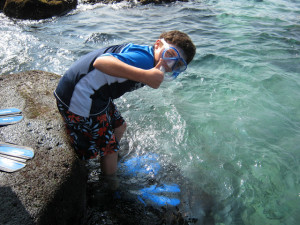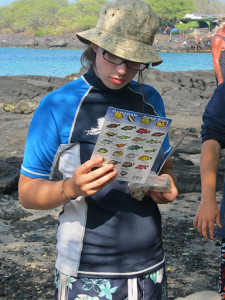 Recently students in the Pacific Quest wilderness therapy program went snorkeling at Pu’uhonua O Honaunau, also known as “Two Step” named for the natural lava steps that lead into the ocean. This popular snorkel spot was once the canoe landing for the Hawaiian chief and his attendants; it was also known as a place of refuge for defeated warriors, and for citizens who violated the sacred laws of the land, also known as “kapu.” In 1819, King Kamehameha II eliminated the kapu system, and in 1961 this area became a national park.
Recently students in the Pacific Quest wilderness therapy program went snorkeling at Pu’uhonua O Honaunau, also known as “Two Step” named for the natural lava steps that lead into the ocean. This popular snorkel spot was once the canoe landing for the Hawaiian chief and his attendants; it was also known as a place of refuge for defeated warriors, and for citizens who violated the sacred laws of the land, also known as “kapu.” In 1819, King Kamehameha II eliminated the kapu system, and in 1961 this area became a national park.
The day began with a discussion of the history of the site and the anticipation of witnessing some of the most diverse coral reef habitats on the island. The group geared up with snorkels, masks, and fins and eased their way into the cr ystal clear blue water where they floated above the coral, and watched the colorful reef fish drift with the moving tide. Students identified sea urchins, hermit crabs and eels, and everyone became excited when they saw a green sea turtle surface for air. After exploring the underwater sights, students made their way out of the water, and gathered around a nearby picnic table for lunch. As students shared the highlights of their underwater adventure, a humpback whale breached in the distance, leaving the group pointing at the horizon and shouting with excitement. It was a great day of fun in the sun, swimming in the ocean, and exploring the ancient history of Hawaii!
ystal clear blue water where they floated above the coral, and watched the colorful reef fish drift with the moving tide. Students identified sea urchins, hermit crabs and eels, and everyone became excited when they saw a green sea turtle surface for air. After exploring the underwater sights, students made their way out of the water, and gathered around a nearby picnic table for lunch. As students shared the highlights of their underwater adventure, a humpback whale breached in the distance, leaving the group pointing at the horizon and shouting with excitement. It was a great day of fun in the sun, swimming in the ocean, and exploring the ancient history of Hawaii!
A Day of Adventure
Recently students in the Pacific Quest wilderness therapy program went snorkeling at Pu’uhonua O Honaunau, also known as “Two Step” named for the natural lava steps that lead into the ocean. This popular snorkel spot was once the canoe landing for the Hawaiian chief and his attendants; it was also known as a place of …
The day began with a discussion of the history of the site and the anticipation of witnessing some of the most diverse coral reef habitats on the island. The group geared up with snorkels, masks, and fins and eased their way into the cr ystal clear blue water where they floated above the coral, and watched the colorful reef fish drift with the moving tide. Students identified sea urchins, hermit crabs and eels, and everyone became excited when they saw a green sea turtle surface for air. After exploring the underwater sights, students made their way out of the water, and gathered around a nearby picnic table for lunch. As students shared the highlights of their underwater adventure, a humpback whale breached in the distance, leaving the group pointing at the horizon and shouting with excitement. It was a great day of fun in the sun, swimming in the ocean, and exploring the ancient history of Hawaii!
ystal clear blue water where they floated above the coral, and watched the colorful reef fish drift with the moving tide. Students identified sea urchins, hermit crabs and eels, and everyone became excited when they saw a green sea turtle surface for air. After exploring the underwater sights, students made their way out of the water, and gathered around a nearby picnic table for lunch. As students shared the highlights of their underwater adventure, a humpback whale breached in the distance, leaving the group pointing at the horizon and shouting with excitement. It was a great day of fun in the sun, swimming in the ocean, and exploring the ancient history of Hawaii!
Questions? Call or Text our Admissions Team: 808-937-5806